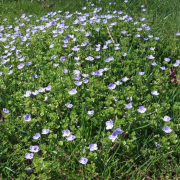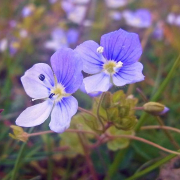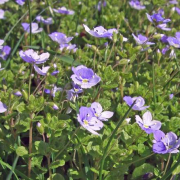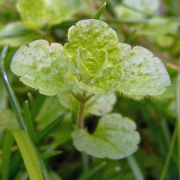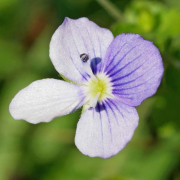Slender speedwell Veronica filiformis
Table of Contents

Plant family: Plantaginaceae
Aliases: Creeping speedwell, whetzel weed
Flowering period: April – July
Flower colour: Lilac – purple – mauve
Preferred soil type: Most types
Habitat: Grassland, hedgerows, lawns
Status: Common
General information
Slender speedwell is a non-native perennial plant, that was imported from Turkey during the early 1800s. Its intended use was a ground cover plant for rock gardens, however, as it is extremely invasive, it became a garden escapee as it spread into the wild.
It became particularly troublesome for gardeners as it has become a major weed in lawns and fine turf. It quickly spreads into dense patches and is nigh on impossible to control, as it’s resistant to herbicides. On top of that it can spread by lose plant fragments (e.g. plants stems, stalks and runners) that are removed (cut) when mowing without a grass collector.
Slender speedwell prefers to grow on moist, fertile sites, but will grow on most types of soil. They thrive in grassy places such as meadows and verges, but are happiest in short grass. It’s a low growing plant, with slender creeping stems, rarely exceeding 20cm in height.
It ‘s often confused with germander speedwell, as they appear similar and grow in similar habitats. The main differences are the flowers, germander flowers are deep blue, whilst slender flowers are a purple – mauve colour. The leaves are generally a deeper green and larger on germander speedwell.

Identification
Flowers: Purlpe – mauve in colour with white centers, quite often the flowers are a deeper colour towards the top and become paler towards the lower petal. Each flower has four petals, they have a bi-lateral symmetry with the widest and largest petal on top, and the narrowest and smallest at the bottom. The flowers measure up to 10mm across, blooming between April and July.
Leaves: The small, light green leaves are round or kidney shaped, often with slightly toothed edges, measuring up to 10 mm in diameter. The leaves are opposite on the non-flower stems and alternate on the flower stems.
Slender speedwell images
Click to enlarge

This work is licensed under a Creative Commons Attribution 4.0 International License.
You are free to use, share and adapt any of the images on this page, under the condition we receive a followed backlink to our website https://diversegardens.co.uk as the image source.


